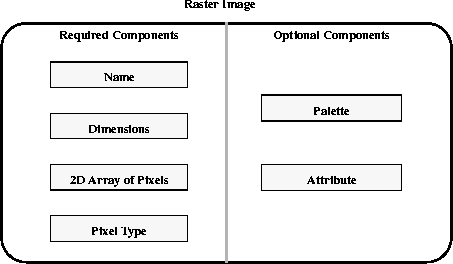

Refer to Figure 8a on page 259 for a graphical overview of the raster image, or GR data set, structure. Note that GR data sets consist of required and optional components.
8.2.1 Required GR Data Set Components
Every GR data set must contain the following components: image array, name, pixel type, and dimensions. The name, dimensions, and pixel type must be supplied by the user at the time the GR data set is defined. Image Array
An image array is a two-dimensional array of pixels. This is the primary data component of the GR model and will be discussed later in this section; it can be compressed, chunked, and/or stored in external files. Refer to Section 8.6.2 on page 268 for a description of raster image compression and Section 8.6.3 on page 268 for a description of external image storage.
A raster image has an index and a reference number associated with it. The index is a non-negative integer that describes the relative position of the raster image in the file. A valid index ranges from 0 to the total number of images in the file minus 1. The reference number is a unique positive integer assigned to the raster image by the GR interface when the image is created. Various GR interface routines can be used to obtain an image index or reference number depending on the available information about the raster image. The index can also be determined if the sequence in which the images are created in the file is known.
Image Array Name
Each image array has a name consisting of a string of case-sensitive alphanumeric characters. The name must be provided by the calling program at the time the image is created, and cannot be changed afterward. Image array names do not have to be unique within a file, but if they are not it can be difficult to distinguish among the raster images in the file. Pixels and Pixel Type
Each element in an image array corresponds to one pixel and each pixel can consist of a number of color component values or pixel components, e.g., Red-Green-Blue or RGB, Cyan-Magenta-Yellow-Black or CMYK, etc. Pixel components can be represented by different methods (8-bit lookup table or 24-bit direct representation, graphically depicted by Figure 6a on page 229 and Figure 7b on page 246, respectively) and may have different data types.
The data type of pixel components and the number of components in each pixel are collectively known as the pixel type. The GR data model supports all of the HDF-supported data types. A list of these data types appears provided in Table 2F on page 14.
Pixels can be composed of any number of components.
Dimensions
Image array dimensions specify the shape of the image array. A raster image array has two limited dimensions. The size of each dimension must be specified at the creation of the image and must be greater than 0. 8.2.2 Optional GR Data Set Components
There are two types of optional components available for inclusion in a GR data set: palettes and attributes. These components are only created when specifically requested by the calling program; the GR interface does not provide predefined palettes or attributes. Palettes
Palettes are lookup tables attached to images and define a set of color values for each pixel value in the image array. The GR interface provides similar capabilities for storing and manipulating palettes as the DFP interface described in Chapter 9, Palettes (DFP API). However, the DFP interface is restricted to single-file operations while the GR interface allows multifile palette operations.
Eventually, all palette manipulation functionality will reside only within the GR interface. In the meantime, the single-file DFP routines are fully compatible with palettes created with the GR palette routines. The GR palette routines are described in Section 8.10 on page 277.
Attributes
Attributes contain auxiliary information about a file, a raster image, or both. The concept of attributes is described in Chapter 3, Scientific Data Sets (SD API).
The GR interface does not support dimension attributes.